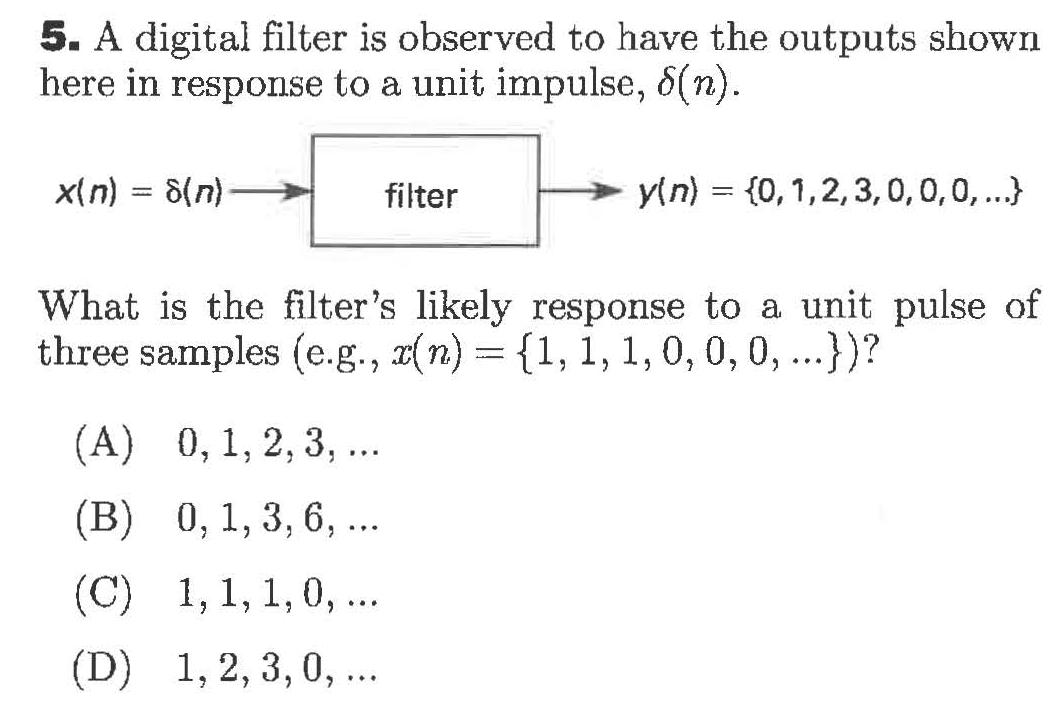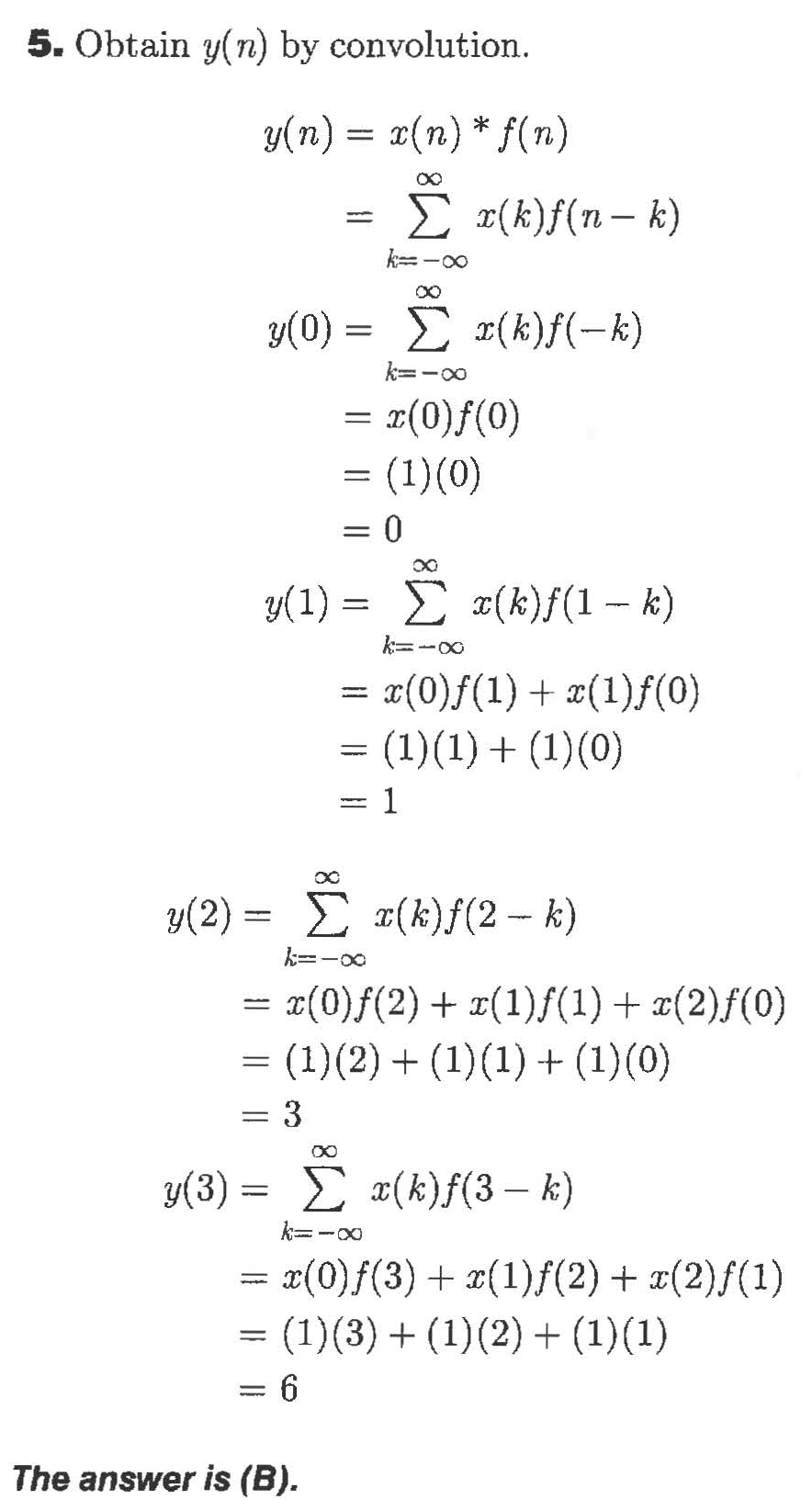5. A digital filter is observed to have the outputs shown here in response to a unit impulse, 6(n) yin) {0,1,2,3,0,0,0,.. x(n) 8(n) filter What is the filter's likely response to a unit pulse of three samples (e.g., x(n)= {1,1,1, 0, 0, 0, .)? (А) 0, 1, 2, 3, .. (В) 0, 1, 3, 6, .. (C) 1,1,1,0,.. 1,2, 3, 0, .. (D) 5. Obtain y(n) by convolution y(n) x(n)* f(n) Σ ( )f (π- t) k oo 0)-Σ (k)f(-k) y(0) k-oo = (0)f(0) (1)(0) = 0 (1) x(k)f(1- k) x(0)f(1)(1)f(0) (1)(1)(10) = 1 (k)f(2 k) y(2) = (0)f(2)(1)(1)(2)f(0) (1)(2)() (1)(0) 3 y(3) x(k)f(3- k) = x(0)f(3)(1)f(2)(2)f(1) = (1)(3)(1)2)(1)(1) = 6 The answer is (B).
5. A digital filter is observed to have the outputs shown here in response to a unit impulse, 6(n) yin) {0,1,2,3,0,0,0,.. x(n) 8(n) filter What is the filter's likely response to a unit pulse of three samples (e.g., x(n)= {1,1,1, 0, 0, 0, .)? (А) 0, 1, 2, 3, .. (В) 0, 1, 3, 6, .. (C) 1,1,1,0,.. 1,2, 3, 0, .. (D) 5. Obtain y(n) by convolution y(n) x(n)* f(n) Σ ( )f (π- t) k oo 0)-Σ (k)f(-k) y(0) k-oo = (0)f(0) (1)(0) = 0 (1) x(k)f(1- k) x(0)f(1)(1)f(0) (1)(1)(10) = 1 (k)f(2 k) y(2) = (0)f(2)(1)(1)(2)f(0) (1)(2)() (1)(0) 3 y(3) x(k)f(3- k) = x(0)f(3)(1)f(2)(2)f(1) = (1)(3)(1)2)(1)(1) = 6 The answer is (B).
Introductory Circuit Analysis (13th Edition)
13th Edition
ISBN:9780133923605
Author:Robert L. Boylestad
Publisher:Robert L. Boylestad
Chapter1: Introduction
Section: Chapter Questions
Problem 1P: Visit your local library (at school or home) and describe the extent to which it provides literature...
Related questions
Question
100%
Hi,
the attached image shows a question and its answer but still, I couldn't understand it please simply explain it

Transcribed Image Text:5. A digital filter is observed to have the outputs shown
here in response to a unit impulse, 6(n)
yin) {0,1,2,3,0,0,0,..
x(n)
8(n)
filter
What is the filter's likely response to a unit pulse of
three samples (e.g., x(n)= {1,1,1, 0, 0, 0, .)?
(А) 0, 1, 2, 3, ..
(В) 0, 1, 3, 6, ..
(C) 1,1,1,0,..
1,2, 3, 0, ..
(D)

Transcribed Image Text:5. Obtain y(n) by convolution
y(n) x(n)* f(n)
Σ ( )f (π- t)
k oo
0)-Σ (k)f(-k)
y(0)
k-oo
= (0)f(0)
(1)(0)
= 0
(1) x(k)f(1- k)
x(0)f(1)(1)f(0)
(1)(1)(10)
= 1
(k)f(2 k)
y(2) =
(0)f(2)(1)(1)(2)f(0)
(1)(2)() (1)(0)
3
y(3)
x(k)f(3- k)
= x(0)f(3)(1)f(2)(2)f(1)
= (1)(3)(1)2)(1)(1)
= 6
The answer is (B).
Expert Solution
This question has been solved!
Explore an expertly crafted, step-by-step solution for a thorough understanding of key concepts.
This is a popular solution!
Trending now
This is a popular solution!
Step by step
Solved in 4 steps with 4 images

Knowledge Booster
Learn more about
Need a deep-dive on the concept behind this application? Look no further. Learn more about this topic, electrical-engineering and related others by exploring similar questions and additional content below.Recommended textbooks for you

Introductory Circuit Analysis (13th Edition)
Electrical Engineering
ISBN:
9780133923605
Author:
Robert L. Boylestad
Publisher:
PEARSON

Delmar's Standard Textbook Of Electricity
Electrical Engineering
ISBN:
9781337900348
Author:
Stephen L. Herman
Publisher:
Cengage Learning

Programmable Logic Controllers
Electrical Engineering
ISBN:
9780073373843
Author:
Frank D. Petruzella
Publisher:
McGraw-Hill Education

Introductory Circuit Analysis (13th Edition)
Electrical Engineering
ISBN:
9780133923605
Author:
Robert L. Boylestad
Publisher:
PEARSON

Delmar's Standard Textbook Of Electricity
Electrical Engineering
ISBN:
9781337900348
Author:
Stephen L. Herman
Publisher:
Cengage Learning

Programmable Logic Controllers
Electrical Engineering
ISBN:
9780073373843
Author:
Frank D. Petruzella
Publisher:
McGraw-Hill Education

Fundamentals of Electric Circuits
Electrical Engineering
ISBN:
9780078028229
Author:
Charles K Alexander, Matthew Sadiku
Publisher:
McGraw-Hill Education

Electric Circuits. (11th Edition)
Electrical Engineering
ISBN:
9780134746968
Author:
James W. Nilsson, Susan Riedel
Publisher:
PEARSON

Engineering Electromagnetics
Electrical Engineering
ISBN:
9780078028151
Author:
Hayt, William H. (william Hart), Jr, BUCK, John A.
Publisher:
Mcgraw-hill Education,